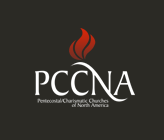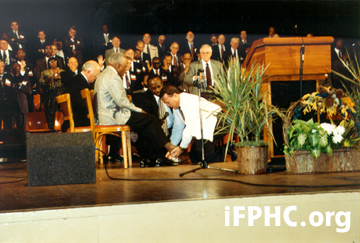The Memphis Manifesto: Five Years Later
 On October 17-19, 1994 the leadership of the essentially all white Pentecostal Fellowship of the North America (PFNA) met in Memphis to confront its racial past and to meet with African American Pentecostals to establish an integrated fellowship. The result was a new organization known as the Pentecostal/Charismatic Churches of North America (PCCNA). As part of that process those present from the PFNA confessed that they had practiced bigotry and exclusiveness in their preference for a congregation and administration of the same color. Five years have passed since this historic event, and it is time to look at the results of the “Memphis miracle” and to take further steps and longer strides to meet the challenge presented there.
On October 17-19, 1994 the leadership of the essentially all white Pentecostal Fellowship of the North America (PFNA) met in Memphis to confront its racial past and to meet with African American Pentecostals to establish an integrated fellowship. The result was a new organization known as the Pentecostal/Charismatic Churches of North America (PCCNA). As part of that process those present from the PFNA confessed that they had practiced bigotry and exclusiveness in their preference for a congregation and administration of the same color. Five years have passed since this historic event, and it is time to look at the results of the “Memphis miracle” and to take further steps and longer strides to meet the challenge presented there.
I have lived in Honolulu for the past 13 years where white people like me are called “haoles”, and are in the minority—some thirty percent of us who live here have European ancestors. I am on the pastoral staff of the largest church in the State. Our congregation of 10,000 looks like it should for our area, seventy percent of the attendees and the staff are people of color and the rest are white.

Donald J. Evans washing the feet of Bishop Ithiel Clemmons during footwashing service at PCCNA at “The Miracle of Memphis” in October 1994.
Image: Flowers Pentecostal Heritage Center
The Memphis Manifesto challenges all believers to take a look at their own attitudes and pre-judgments regarding race. In light of this, the first point I want to make is that white is also a color, and that everyone in my church therefore is a person of color. I know too that everyone in your church is a person of color, hence the problem we face is not one of color but one of preference. Preference is sin.
My friend Helen W. was a missionary in Liberia for many many years. She left the field in the sixties and came back to Fort Washington, PA to work in the home office of her sending agency. Helen had malaria and could not stay any longer. She went to Liberia as a young single woman and while there met and fell in love with a local man. Her sending agency would not let them marry—he was black, she was white; it would not be good, they said.
I lived near Helen back then. I lived in a white neighborhood and was appalled to learn that Helen spent all her free time in the black areas of Philadelphia. I admonished her, she could get hurt down there. Helen said, “Oh no.” She explained that she had lived for twenty years as the only white woman in the bush of Liberia, a country where white people played a leading role in government. In those twenty years, Helen had learned that you were far safer in the black community than with the white ones who governed and could not be trusted. Helen found crowds of white people frightening. Back in the sixties, I found black people frightening.
Category: Ministry, Spring 2000


